
 |
Understanding Proposition 218 |
The purpose of this guide is to help the Legislature, local
officials, and other parties understand Proposition 218, including
the actions local governments must take to implement it. The guide
includes five chapters:
Finally, the appendix to this guide summarizes major areas
of uncertainty pertaining to Proposition 218 (some of which the
Legislature may wish to address), and includes the text of
Proposition 218 (now Article XIII C and D of the California
Constitution).
How Proposition 218 Changes
Since that time, many local governments have relied
increasingly upon other revenue tools to finance local services,
most notably: assessments, property-related fees, and a variety
of small general purpose taxes (such as hotel, business license,
and utility user taxes). It is the use of these local revenue tools
that is the focus of Proposition 218.
In general, the intent of Proposition 218 is to ensure that all
taxes and most charges on property owners are subject to voter
approval. In addition, Proposition 218 seeks to curb some perceived
abuses in the use of assessments and property-related fees,
specifically the use of these revenue-raising tools to pay for general
governmental services rather than property-related services.
In this chapter, we provide an overview and perspective on
the impact of Proposition 218 on local finance and governance.
In this guide, we provide our interpretation of the measure's
requirements. This interpretation is based on our extensive review
of the measure, as well as consultations with the measure's
drafters, local government officials, and legal counsel. In some
cases, however, we are not able to fully ascertain the meaning
or scope of a Proposition 218 requirement. We believe our
uncertainty--frequently shared by other analysts of the
measure--will be resolved only when the Legislature enacts
implementing statutes or court rulings become available.
Accordingly, throughout this guide we discuss Proposition 218
as we understand it. Where other parties have different opinions
or the measure's requirements are not clear, we provide this
information. Finally, we provide in Appendix I a summary of the
areas in which clarifying legislative or judicial action may be
necessary.
Given the relatively small number and dollar value of local
revenue sources that are affected by Proposition 218, we think
it is highly unlikely that the measure could cause more than a
5 percent annual decrease in aggregate local government own-source revenues.
Second, many local governments have limited flexibility to
reduce programs when revenues decline. Most major county
programs, for example, are subject to state and federal mandates
and spending requirements. As a result, relatively small revenue
losses can trigger significant reductions to the few programs over
which the local government has control.
Finally, many local governments will experience both revenue
reductions and cost increases to comply with Proposition 218.
For example, some local governments will lose part of their
assessment and fee revenues, and have to pay:
These increased costs will increase the fiscal impact of this
measure on local government programs.
Proposition 218 also requires local governments to place before
the voters certain existing assessments and taxes. Unless the
voters ratify these assessments and taxes, local governments
will experience additional revenues losses, potentially exceeding
$100 million annually.
Unless these reduced local revenues are replaced with other
revenues, local government spending for local public services
will decrease accordingly. What other revenues could offset these
revenue reductions? It is likely that local governments will pursue
one or more of the following sources of potential replacement
revenues:
Limited Ability to Raise Replacement Revenues. Local
governments' ability to expand these six other revenue sources
is not great. Various legal and practical restrictions limit a major
expansion of redevelopment or developer exactions, for example.
In addition, many local government observers believe that existing
hotel and business taxes are already high and not all parts of the
state have major entertainment or sporting centers. (We include
these taxes on the above list because these taxes are not paid
directly by most voters. Thus, the likelihood of their being approved
by a majority of voters may be higher than other general taxes.)
Similarly, while local governments in California have had
difficulty securing the requisite two-thirds vote to impose special
taxes, it is likely that some additional special taxes will be approved.
Special taxes probably are more likely to be adopted in small,
discrete areas of a community where the commonality of interest
is high, however, rather than on a community-wide basis. Thus,
the likelihood of generating significant revenues from special taxes
is not great.
Additional major revenues from the state or federal government
also do not appear likely, given the fiscal limitations faced by both
these level of governments. (Please see our November 1996
publication, California's Fiscal Outlook, for our projections of the
state's fiscal condition.)
This leaves the last revenue source on our list: non-property
related fees. Ultimately, the ability of local government to expand
this revenue source turns on how the term "property-related" fee
is defined by the Legislature or courts. If the definition of a property-related fee is broad, then local government's ability to replace
revenues lost by Proposition 218 is limited. Conversely, if this
definition is narrow, then local government will have greater
opportunities to replace lost revenues with expanded non property-related fees. (Even then, however, the state Constitution and
statutes do not permit local government to charge fees in excess
of costs.)
All in all, our review indicates that most local governments will
have some ability to raise revenues to replace some of the funding
lost by Proposition 218. This ability, however, is limited. Accordingly,
we expect that in the long term, local governments will raise
somewhat less revenues than they would have otherwise--and
local government revenues will come from somewhat different
sources. These revenue reductions will result in lower payments
by people and businesses to government--and decreased
spending for local public services.
Proposition 218 shifts most of this power over taxation from
locally elected governing boards to residents and property owners.
In order to fulfill this considerable responsibility, local residents
and property owners will need greater information on local
government finances and responsibilities. Even with this
information, however, the task of local residents and property
owners will be difficult, given the frequently confusing manner in
which program responsibilities are shared between state and local
government, and among local governments.
Second, the Legislature will probably receive requests for fiscal
assistance from local governments. These requests are likely to
begin in the spring of 1997, as the fiscal consequences of the
assessment and fee restrictions become apparent. Local
governments are likely to turn to the state because it has more
fiscal flexibility than local government. For example, the Legislature
may raise taxes at any time with a two-thirds vote of its members.
Finally, any effort to restructure state-local program responsibilities is now more complicated. Specifically, the Legislature will have
less flexibility to realign programs in a manner that increases local
government responsibility without providing a direct subvention
of state funds. This is because local governments have little or
no flexibility to adjust their own revenues.
Understanding the Vocabulary of Proposition 218
Any discussion of Proposition 218 requires an explanation
of several local government finance words and terms. This chapter
explains the vocabulary.
Are Existing Revenues Affected by Proposition 218?
Local governments must bring their existing taxes, assessments
and property-related fees into conformity with Proposition 218.
The deadline for each of these actions is:
Below, we discuss Proposition 218's requirements regarding
existing taxes, assessments, and fees. (The requirements for new
or increased revenue raising tools is the topic of the next chapter.)
After each section, we answer some common questions regarding
Proposition 218's requirements.
In order to continue such a tax, Proposition 218 requires the
governing body to place the tax before the voters by November 6,
1998. Unless the governing body unanimously votes to declare
the election an emergency, the tax election must be consolidated
with a regularly scheduled election for members of the governing
body. The local government may continue an existing tax if it is
approved by a majority vote.
Our review indicates that more than half of all existing
assessments are likely to be exempt. Generally, this is because
the assessment's funds are used for one of the approved purposes
or are pledged to bond repayment--or the assessment was agreed
to by a land developer, the sole property owner at the time the
assessment was established.
If an assessment is not exempt, then the local government
must eliminate the assessment or bring it into compliance with
Proposition 218's assessment calculation and election requirements
(described below). Our review indicates that the types of
assessments that are not likely to satisfy any of the conditions
for exemption are: fire, lighting and landscaping, and park and
recreation assessments.
First: Determine If a Project or Service Provides Special
Benefits. The local government must determine whether property
owners would receive a "special benefit" from the project or service
to be financed by the assessment. Proposition 218 defines a
special benefit as a particular benefit to land and buildings, not
a general benefit to the public or a general increase in property
values. If a project or service would not provide such a special
benefit, Proposition 218 states that it may not be financed by an
assessment. Our review indicates that local governments will find
it difficult to demonstrate that some existing assessments for
ambulance, library, police, business improvement, and other
services satisfy this tightened definition of special benefit. As a
consequence, some existing assessments may need to be
eliminated.
Second: Estimate the Amount of Special Benefit. Local
government must use a professional engineer's report to estimate
the amount of special benefit landowners would receive from the
project or service, as well as the amount of "general benefit." This
step is needed because Proposition 218 allows local government
to recoup from assessments only the proportionate share of cost
to provide the special benefit. That is, if special benefits represent
50 percent of total benefits, local government may use assessments
to recoup half the project or service's costs. Local governments
must use other revenues to pay for any remaining costs. This
limitation on the use of assessments represents a major change
from the law prior to Proposition 218, when local governments
could recoup from assessments the costs of providing both general
and special benefits.
Third: Set Assessment Charges Proportionally. Finally,
the local government must set individual assessment charges
so that no property owner pays more than his or her proportional
share of the total cost. This may require the local government to
set assessment rates on a parcel-by-parcel basis. Properties owned
by schools and other governmental agencies--previously exempt
from some assessment charges--now must pay assessments.
After mailing the notices, the local government must hold a
public hearing. At the conclusion of the hearing, the local
government must tabulate the ballots, weighing them in proportion
to the amount of the assessment each property owner would pay.
(For example, if homeowner Jones would pay twice as much
assessment as homeowner Smith, homeowner Jones' vote would
"count" twice as much as homeowner Smith's vote.) The
assessment may be imposed only if 50 percent or more of the
weighted ballots support the assessment.
In order to comply with these restrictions, local governments
will need to eliminate or reduce some existing fees. For example,
some small cities currently charge property owners fees for
ambulance or fire service. Proposition 218 does not permit
governments to impose property-related fees for these purposes.
Similarly, some cities collect "franchise fees" or "in-lieu property
taxes" from their water departments and deposit these revenues
into their general funds. The cost of these franchise fees and taxes
is passed onto local residents in terms of higher water fees. If water
fees are considered property-related fees, then Proposition 218
would forbid this diversion of fee revenues. (Some local government
observers believe that this diversion of fee revenues was
impermissible prior to Proposition 218, as well.)
Possible Local Government Response to Fee Restrictions.
In some cases, it may be possible for a local government to
restructure a property-related fee so that it would no longer be
considered a fee imposed "as an incident of property ownership."
For example, a mandatory per parcel garbage collection fee may
be considered a property-related fee, while an optional garbage
collection service charge may not. Similarly, some local governments may be able to show that their franchise fee or in-lieu
property tax represents their water department's reasonable share
of central administrative expenses. If so, then Proposition 218
would not prohibit this transfer of revenues from the water
department. Finally, some local governments may elect to privatize
certain functions formally financed by property-related fees.
Proposition 218 imposes no limit on private fees.
This fee rate calculation requirement--sometimes called the
"proportionality" requirement--will make it difficult for local
government to continue certain programs, such as those that offer
reduced rates to low-income residents. This is because local
governments typically finance these lower rates by charging higher
rates to other property-owners. If these fees are considered
property-related fees, the higher rates would not be permitted by
Proposition 218. In order to continue these programs in the future,
therefore, the local government would need to offset the cost of
the program with other revenues, such as general tax revenues.
What Must a Local Government Do to In order to raise a new tax, assessment, or property-related
fee, or to increase an existing one, local governments must comply
with many of the same provisions discussed in the previous
chapter. In general, these requirements are that local governments
may use assessments and property-related fees only to finance
projects and services that directly benefit property--and that most
revenue-raising measures be approved in an election. Figure 5
summarizes the vote required in these elections.
This chapter explains the steps local government must take
to raise a new tax, assessment or property-related fee, or to
increase an existing one.
As a practical matter, this requirement will mean that programs
that benefit people, rather than specific properties--such as
libraries, mosquito abatement, recreation programs, police
protection, and some business improvement programs--must
be financed by general or special taxes or by other nonassessment
revenues.
Local governments must also:
As a practical matter, local governments will find it much more
difficult--and expensive--to impose or increase property-related
fees. In some cases, local governments are probably more likely
to try to raise revenues through non property-related fees or taxes.
May Residents Overturn Local Taxes, Proposition 218 eliminates any ambiguity regarding the power
of local residents to use the initiative by stating that residents of
California shall have the power to repeal or reduce any local tax,
assessment, or fee. In addition, the measure forbids the Legislature
and local governments from imposing a signature requirement
for local initiatives that is higher than that applicable to statewide
statutory initiatives. As a consequence of these provisions, the
only limits on local residents' ability to overturn local revenue raising
measures appear to be those in the federal constitution, such as
the federal debt impairment clause.
Areas in Which Legislative or Judicial Because Proposition 218 sets a July 1, 1997 deadline for local
governments to bring existing fees and assessments into conformity
with the measure's requirements, legislative or judicial clarification
on questions related to assessments and fees is needed as soon
as possible.
Text of Proposition 218
This initiative measure adds Articles XIII C and D to the California Constitution.
SECTION 1. Definitions. As used in this article:
(a) ''General tax" means any tax imposed for general governmental purposes.
(b) ''Local government" means any county, city, city and county, including
a charter city or county, any special district, or any other local or regional
governmental entity.
(c) ''Special district" means an agency of the state, formed pursuant to general
law or a special act, for the local performance of governmental or proprietary
functions with limited geographic boundaries including, but not limited to, school
districts and redevelopment agencies.
(d) ''Special tax" means any tax imposed for specific purposes, including
a tax imposed for specific purposes, which is placed into a general fund.
SEC. 2. Local Government Tax Limitation. Notwithstanding any other provision
of this Constitution:
(a) All taxes imposed by any local government shall be deemed to be either
general taxes or special taxes. Special purpose districts or agencies, including
school districts, shall have no power to levy general taxes.
(b) No local government may impose, extend, or increase any general tax
unless and until that tax is submitted to the electorate and approved by a majority
vote. A general tax shall not be deemed to have been increased if it is imposed
at a rate not higher than the maximum rate so approved. The election required
by this subdivision shall be consolidated with a regularly scheduled general election
for members of the governing body of the local government, except in cases
of emergency declared by a unanimous vote of the governing body.
(c) Any general tax imposed, extended, or increased, without voter approval,
by any local government on or after January 1, 1995, and prior to the effective
date of this article, shall continue to be imposed only if approved by a majority
vote of the voters voting in an election on the issue of the imposition, which
election shall be held within two years of the effective date of this article and
in compliance with subdivision (b).
(d) No local government may impose, extend, or increase any special tax
unless and until that tax is submitted to the electorate and approved by a
two-thirds vote. A special tax shall not be deemed to have been increased if
it is imposed at a rate not higher than the maximum rate so approved.
SEC. 3. Initiative Power for Local Taxes, Assessments, Fees and Charges.
Notwithstanding any other provision of this Constitution, including, but not limited
to, Sections 8 and 9 of Article II, the initiative power shall not be prohibited or
otherwise limited in matters of reducing or repealing any local tax, assessment,
fee or charge. The power of initiative to affect local taxes, assessments, fees
and charges shall be applicable to all local governments and neither the
Legislature nor any local government charter shall impose a signature requirement
higher than that applicable to statewide statutory initiatives.
Article XIII D is added to the California Constitution to read:
SECTION 1. Application. Notwithstanding any other provision of law, the
provisions of this article shall apply to all assessments, fees and charges, whether
imposed pursuant to state statute or local government charter authority. Nothing
in this article or Article XIII C shall be construed to:
(a) Provide any new authority to any agency to impose a tax, assessment,
fee, or charge.
(b) Affect existing laws relating to the imposition of fees or charges as a
condition of property development.
(c) Affect existing laws relating to the imposition of timber yield taxes.
SEC. 2. Definitions. As used in this article:
(a) ''Agency" means any local government as defined in subdivision (b) of
Section 1 of Article XIII C.
(b) ''Assessment" means any levy or charge upon real property by an agency
for a special benefit conferred upon the real property. ''Assessment" includes,
but is not limited to, ''special assessment," ''benefit assessment," ''maintenance
assessment" and ''special assessment tax."
(c) ''Capital cost" means the cost of acquisition, installation, construction,
reconstruction, or replacement of a permanent public improvement by an agency.
(d) ''District" means an area determined by an agency to contain all parcels
which will receive a special benefit from a proposed public improvement or
property-related service.
(e) ''Fee" or ''charge" means any levy other than an ad valorem tax, a special
tax, or an assessment, imposed by an agency upon a parcel or upon a person
as an incident of property ownership, including a user fee or charge for a property
related service.
(f) ''Maintenance and operation expenses" means the cost of rent, repair,
replacement, rehabilitation, fuel, power, electrical current, care, and supervision
necessary to properly operate and maintain a permanent public improvement.
(g) ''Property ownership" shall be deemed to include tenancies of real property
where tenants are directly liable to pay the assessment, fee, or charge in question.
(h) ''Property-related service" means a public service having a direct
relationship to property ownership.
(i) ''Special benefit" means a particular and distinct benefit over and above
general benefits conferred on real property located in the district or to the public
at large. General enhancement of property value does not constitute ''special
benefit."
SEC. 3. Property Taxes, Assessments, Fees and Charges Limited. (a) No
tax, assessment, fee, or charge shall be assessed by any agency upon any
parcel of property or upon any person as an incident of property ownership except:
(1) The ad valorem property tax imposed pursuant to Article XIII and Article
XIII A.
(2) Any special tax receiving a two-thirds vote pursuant to Section 4 of Article
XIII A.
(3) Assessments as provided by this article.
(4) Fees or charges for property related services as provided by this article.
(b) For purposes of this article, fees for the provision of electrical or gas
service shall not be deemed charges or fees imposed as an incident of property
ownership.
SEC. 4. Procedures and Requirements for All Assessments. (a) An agency
which proposes to levy an assessment shall identify all parcels which will have
a special benefit conferred upon them and upon which an assessment will be
imposed. The proportionate special benefit derived by each identified parcel
shall be determined in relationship to the entirety of the capital cost of a public
improvement, the maintenance and operation expenses of a public improvement,
or the cost of the property related service being provided. No assessment shall
be imposed on any parcel which exceeds the reasonable cost of the proportional
special benefit conferred on that parcel. Only special benefits are assessable,
and an agency shall separate the general benefits from the special benefits
conferred on a parcel. Parcels within a district that are owned or used by any
agency, the State of California or the United States shall not be exempt from
assessment unless the agency can demonstrate by clear and convincing evidence
that those publicly owned parcels in fact receive no special benefit.
(b) All assessments shall be supported by a detailed engineer's report
prepared by a registered professional engineer certified by the State of California.
(c) The amount of the proposed assessment for each identified parcel shall
be calculated and the record owner of each parcel shall be given written notice
by mail of the proposed assessment, the total amount thereof chargeable to
the entire district, the amount chargeable to the owner's particular parcel, the
duration of the payments, the reason for the assessment and the basis upon
which the amount of the proposed assessment was calculated, together with
the date, time, and location of a public hearing on the proposed assessment.
Each notice shall also include, in a conspicuous place thereon, a summary of
the procedures applicable to the completion, return, and tabulation of the ballots
required pursuant to subdivision (d), including a disclosure statement that the
existence of a majority protest, as defined in subdivision (e), will result in the
assessment not being imposed.
(d) Each notice mailed to owners of identified parcels within the district
pursuant to subdivision (c) shall contain a ballot which includes the agency's
address for receipt of the ballot once completed by any owner receiving the
notice whereby the owner may indicate his or her name, reasonable identification
of the parcel, and his or her support or opposition to the proposed assessment.
(e) The agency shall conduct a public hearing upon the proposed assessment
not less than 45 days after mailing the notice of the proposed assessment to
record owners of each identified parcel. At the public hearing, the agency shall
consider all protests against the proposed assessment and tabulate the ballots.
The agency shall not impose an assessment if there is a majority protest. A
majority protest exists if, upon the conclusion of the hearing, ballots submitted
in opposition to the assessment exceed the ballots submitted in favor of the
assessment. In tabulating the ballots, the ballots shall be weighted according
to the proportional financial obligation of the affected property.
(f) In any legal action contesting the validity of any assessment, the burden
shall be on the agency to demonstrate that the property or properties in question
receive a special benefit over and above the benefits conferred on the public
at large and that the amount of any contested assessment is proportional to,
and no greater than, the benefits conferred on the property or properties in
question.
(g) Because only special benefits are assessable, electors residing within
the district who do not own property within the district shall not be deemed under
this Constitution to have been deprived of the right to vote for any assessment.
If a court determines that the Constitution of the United States or other federal
law requires otherwise, the assessment shall not be imposed unless approved
by a two-thirds vote of the electorate in the district in addition to being approved
by the property owners as required by subdivision (e).
SEC. 5. Effective Date. Pursuant to subdivision (a) of Section 10 of Article
II, the provisions of this article shall become effective the day after the election
unless otherwise provided. Beginning July 1, 1997, all existing, new, or increased
assessments shall comply with this article. Notwithstanding the foregoing, the
following assessments existing on the effective date of this article shall be exempt
from the procedures and approval process set forth in Section 4:
(a) Any assessment imposed exclusively to finance the capital costs or
maintenance and operation expenses for sidewalks, streets, sewers, water,
flood control, drainage systems or vector control. Subsequent increases in such
assessments shall be subject to the procedures and approval process set forth
in Section 4.
(b) Any assessment imposed pursuant to a petition signed by the persons
owning all of the parcels subject to the assessment at the time the assessment
is initially imposed. Subsequent increases in such assessments shall be subject
to the procedures and approval process set forth in Section 4.
(c) Any assessment the proceeds of which are exclusively used to repay
bonded indebtedness of which the failure to pay would violate the Contract
Impairment Clause of the Constitution of the United States.
(d) Any assessment which previously received majority voter approval from
the voters voting in an election on the issue of the assessment. Subsequent
increases in those assessments shall be subject to the procedures and approval
process set forth in Section 4.
SEC. 6. Property Related Fees and Charges. (a) Procedures for New or
Increased Fees and Charges. An agency shall follow the procedures pursuant
to this section in imposing or increasing any fee or charge as defined pursuant
to this article, including, but not limited to, the following:
(1) The parcels upon which a fee or charge is proposed for imposition shall
be identified. The amount of the fee or charge proposed to be imposed upon
each parcel shall be calculated. The agency shall provide written notice by mail
of the proposed fee or charge to the record owner of each identified parcel upon
which the fee or charge is proposed for imposition, the amount of the fee or
charge proposed to be imposed upon each, the basis upon which the amount
of the proposed fee or charge was calculated, the reason for the fee or charge,
together with the date, time, and location of a public hearing on the proposed
fee or charge.
(2) The agency shall conduct a public hearing upon the proposed fee or
charge not less than 45 days after mailing the notice of the proposed fee or
charge to the record owners of each identified parcel upon which the fee or charge
is proposed for imposition. At the public hearing, the agency shall consider all
protests against the proposed fee or charge. If written protests against the
proposed fee or charge are presented by a majority of owners of the identified
parcels, the agency shall not impose the fee or charge.
(b) Requirements for Existing, New or Increased Fees and Charges. A fee
or charge shall not be extended, imposed, or increased by any agency unless
it meets all of the following requirements:
(1) Revenues derived from the fee or charge shall not exceed the funds
required to provide the property related service.
(2) Revenues derived from the fee or charge shall not be used for any
purpose other than that for which the fee or charge was imposed.
(3) The amount of a fee or charge imposed upon any parcel or person as
an incident of property ownership shall not exceed the proportional cost of the
service attributable to the parcel.
(4) No fee or charge may be imposed for a service unless that service is
actually used by, or immediately available to, the owner of the property in question.
Fees or charges based on potential or future use of a service are not permitted.
Standby charges, whether characterized as charges or assessments, shall be
classified as assessments and shall not be imposed without compliance with
Section 4.
(5) No fee or charge may be imposed for general governmental services
including, but not limited to, police, fire, ambulance or library services, where
the service is available to the public at large in substantially the same manner
as it is to property owners. Reliance by an agency on any parcel map, including,
but not limited to, an assessor's parcel map, may be considered a significant
factor in determining whether a fee or charge is imposed as an incident of property
ownership for purposes of this article. In any legal action contesting the validity
of a fee or charge, the burden shall be on the agency to demonstrate compliance
with this article.
(c) Voter Approval for New or Increased Fees and Charges. Except for fees
or charges for sewer, water, and refuse collection services, no property related
fee or charge shall be imposed or increased unless and until that fee or charge
is submitted and approved by a majority vote of the property owners of the
property subject to the fee or charge or, at the option of the agency, by a
two-thirds vote of the electorate residing in the affected area. The election shall
be conducted not less than 45 days after the public hearing. An agency may
adopt procedures similar to those for increases in assessments in the conduct
of elections under this subdivision.
(d) Beginning July 1, 1997, all fees or charges shall comply with this section.
Note: Understanding Proposition 218 was published in December 1996, less than one month after the state's voters approved Proposition 218. The report was written as a layperson's guide to Proposition 218 and has not been updated since 1996.
If you have questions about local finance or Proposition 218, you may wish to consult an attorney or review other online publications. For example, the sponsors of Proposition 218 (the Howard Jarvis Taxpayers Association) and the California League of Cities offer materials regarding Proposition 218 on their websites. The League of Cities' primary document regarding Proposition 218 is called "Proposition 218: Implementation Guide. "
Introduction
Proposition 218 significantly changes local government finance.
This constitutional initiative--approved by the state's voters in
November 1996--applies to each of California's nearly 7,000 cities,
counties, special districts, schools, community college districts,
redevelopment agencies, and regional organizations.
Chapter 1
Local Finance and Governance
Nearly two decades ago, Proposition 13 sharply constrained
local governments' ability to raise property taxes, the mainstay
of local government finance. Proposition 13 also specified that
any local tax imposed to pay for specific governmental programs--a
"special tax"--must be approved by two-thirds of the voters.
Proposition 218 Changes Local Government Finance
Proposition 218 makes several important changes regarding
local government finance. Figure 1 summarizes our observations
regarding their fiscal impact.
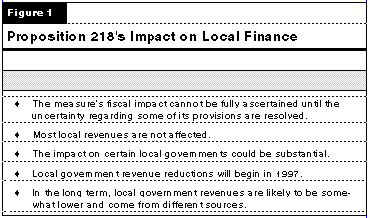
Some Uncertainty Regarding Proposition 218's Provisions
Proposition 218's requirements span a large spectrum, including
local initiatives, water standby charges, legal standards of proof,
election procedures, and the calculation and use of sewer
assessment revenues. Although the measure is quite detailed
in many respects, some important provisions are not completely
clear.
Most Local Revenues Are Not Affected
California local governments raise more than $50 billion
annually from taxes, assessments, and fees. As Figure 2 shows,
most of these local revenues are not affected directly by
Proposition 218. Instead, Proposition 218's provisions apply to
a relatively small subset of local government revenues.
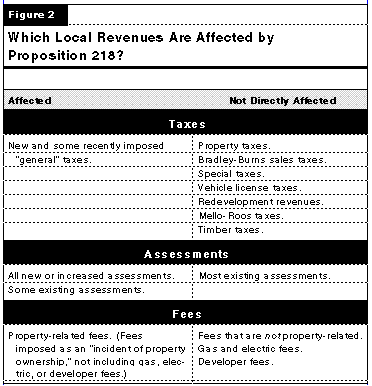
Impact on Certain Local Governments May Be Substantial
The actual impact of Proposition 218 on local public services
may be greater than our 5 percent estimate would suggest,
however, for a variety of reasons. First, some governments are
highly reliant upon the types of assessments and fees that would
be restricted by this measure. These local governments--typically,
small, newly incorporated cities, and library, fire, and park and
recreation special districts--may sustain revenue reductions of
much more than 5 percent. Some special districts also lack the
authority to propose taxes to replace the lost assessment and
fee revenues.
Fiscal Impact Begins in 1997
The fiscal impact of Proposition 218 will begin almost
immediately. Within eight months of Proposition 218's passage,
local governments will need to reduce or eliminate certain existing
assessments and fees to meet the measure's requirements. (These
requirements are discussed in Chapter Three.) We estimate that
these actions will reduce local government revenues by at least
$100 million in 1997-98.
Longer Term: Different Revenue Sources, Probably Less Money
Proposition 218 restricts local governments' ability to impose
assessments and property-related fees--and requires elections
to approve many local government revenue raising methods.
Because of this, it is likely that over the long term local governments
will raise fewer revenues from assessments, property-related fees,
and some taxes.
Proposition 218 Changes Local Governance
In addition to changing local finance, Proposition 218 changes
the governance roles and responsibilities of local residents and
property owners, local government, and potentially, the state. While
the full ramifications of these changes will not be known for years
to come, some elements are already apparent.
Increased Role for Local Residents And Property Owners
Prior to Proposition 218, the local resident and property owner's
role in approving most new local government revenue-raising
measures was minimal. Local governments typically raised new
funds by imposing new or increased assessments or fees, or in
the case of charter cities, general-purpose taxes on utility use,
business licences, and hotel occupancy. In most cases, California
residents or property owners could object to these taxes or charges
at a public hearing or during a statutory protest procedure, but
these taxes or charges were not placed on the ballot. In short,
locally elected governing bodies held most of the power over local
revenue raising.
Local Government Remains Responsible for Expenditures
Local government's powers, in contrast, become significantly
constrained. While locally elected governing boards continue to
be fully responsible for decision-making regarding the expenditure
of public funds, they now have very little authority to raise funds
without a vote of the residents or property owners. In addition,
Proposition 218 limits local government's authority to call an
election to raise revenues. Specifically, except in cases of
emergency, local governments now may hold elections on general
taxes only once every two years (consolidated with an election
for members of the governing board.) Moreover, Proposition 218
limits the amount of an assessment or property-related fee that
may be put before the property owners for a vote.
State Government Role May Expand
Proposition 218 may also alter the state's role and responsibilities regarding local government in several important ways. First,
the Legislature will be asked to play a large role in interpreting
Proposition 218's requirements, and helping set the rules regarding
local government finance. In some cases, local governments are
likely to ask for urgency legislation to enact these measures
because the deadline for compliance with some Proposition 218
provisions is July 1, 1997.
Chapter 2
What Is a Tax?
Taxes are government's most flexible revenue raising tool.
A tax is a charge on an individual or business that pays for
governmental services or facilities that benefit the public broadly.
There need not be any direct relationship between how much tax
a person pays and how much service he or she receives from
government. Example of taxes include the property tax, sales tax,
business licence tax, hotel occupancy tax, and utility users tax.
Special Tax Versus General Tax
A tax is called a "special" tax if its revenues are used for specific
purposes and a "general" tax if its revenues may be used for any
governmental purpose. This distinction is important because it
determines whether a tax must be approved by a majority vote
of the electorate (general tax)--or a two-thirds vote (special tax).
What Is an Assessment?
An assessment is a charge levied on property to pay for a public
improvement or service that benefits property. Assessments are
usually collected on the regular property tax bill. They are different,
however, from the regular 1 percent property tax and property
tax debt overrides in that assessment rates are not based on the
value of the property. Assessments are also different from another
charge that sometimes is placed on the property tax bill, parcel
taxes. Unlike parcel taxes, assessments typically were not voter
approved prior to Proposition 218. In addition, assessment rates
were linked to the cost of providing a service or improvement,
whereas parcel taxes could be set at any amount. Typical
assessments include those for flood control improvements, streets,
and lighting and landscaping.
What Is a Fee?
A fee is a charge imposed on an individual or business for
a service or facility provided directly to an individual or business.
Local governments charge fees for a wide range of purposes,
from park entry fees to building plan check fees. The amount of
the fee may not exceed the cost of government to provide the
service.
A New Term: "Property-Related Fee"
Proposition 218 restricts property-related fees, defined as fees
imposed "as an incident of property ownership." At this time, there
is no consensus as to which fees meet this definition. The drafters
of Proposition 218 indicate that it was their intent to include most
fees commonly collected on monthly bills to property owners, such
as those for water delivery, garbage service, sewer service, and
storm water management fees. Other analysts of Proposition 218
contend that fees that vary by level of service (for example, a fee
for metered water usage) should not be considered a property-related fee, because it is based on service usage, rather than
property ownership. Because Proposition 218 does not restrict
nonproperty-related fees, the definition of this term will be an
important and sensitive issue for the Legislature and courts.
Overlapping Terms
While the terms tax, assessment, and fee are each legally
distinct, in practice they overlap. For example, communities in
California may finance streets from taxes, assessments, and/or
fees. In addition, local government officials sometimes call a charge
one term, when it was legally adopted as another. As a result,
the work of sorting out whether a particular charge must comply
with Proposition 218's requirements for a tax, assessment, or fee
will not always be easy.
Chapter 3
Requirements for Existing Taxes
Proposition 218 does not affect existing special taxes or most
general taxes. Proposition 218 affects only those general taxes
that were imposed in 1995 or 1996 without a vote of the people.
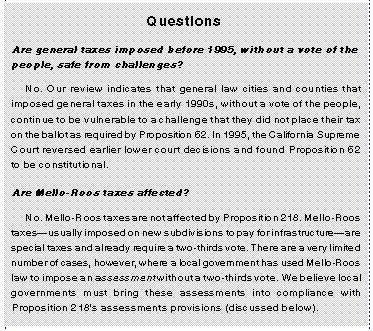
Requirements for Existing Assessments
Local governments must review all existing assessments,
including standby-charges (which the measure defines as
assessments). Figure 3 (see next page) shows the actions local
governments must take to bring their existing assessments into
compliance with Proposition 218.
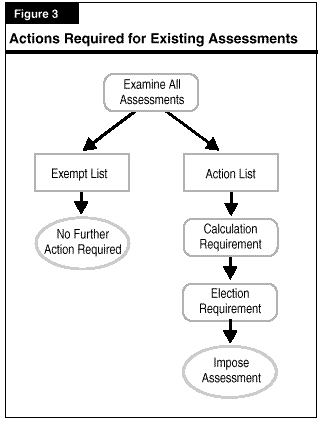
The Examination Requirement:
Local government must examine each assessment to determine
whether it meets one of the conditions for placement on the
"exempt list." These conditions are:
Many Assessments Will Qualify for Exempt List
The Calculation Requirement: One of
Local governments must recalculate all existing assessments
that do not qualify for the exempt list. Our review indicates that
in many cases, Proposition 218's provisions regarding the
calculation of assessments will result in local governments lowering
the amount they collect in assessments from property owners,
or eliminating the assessment. We identify the specific calculation
provisions below.
Proposition 218's Most Significant ChangesElection Requirement: All Property-Owners
Local governments must mail information regarding assessments to all property owners. (Prior to Proposition 218, large
communities could publish assessment information, rather than
mail it to every property owner.) Each assessment notice must
contain a mail-in ballot for the property owner to indicate his or
her approval or disapproval of the assessment.
Vote on Assessments
Requirements for Existing Fees
As with assessments, local governments must complete a multi-step review of all fees. Figure 4 summarizes the process.
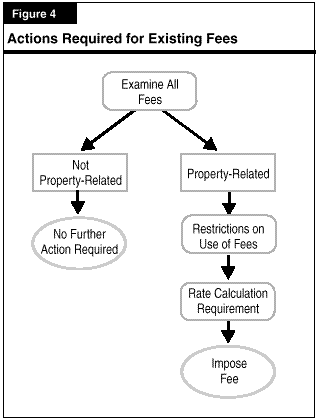
Examination Requirement:
Local government must begin by examining all existing fees
to determine whether they are "property-related" fees, imposed
as an "incident of property ownership." (We discuss this term and
the controversy surrounding it in Chapter Two). As Figure 4 shows,
if a fee is not property-related, then the local government need
not take any further action regarding the fee. Conversely, if the
fee is property-related, then the local government must make sure
that the fee complies with Proposition 218's restrictions on use
of fee revenues and the rate calculation requirements. The deadline
for these actions is July 1, 1997.
Identifying Property-Related FeesNew Restrictions on Use of Fees
Proposition 218 specifies that no property-related fee may
be:
Fee Rate Calculation Requirement
After complying with Proposition 218's restrictions on the use
of property-related fees, the local government must make sure
that its property-related fees comply with the measure's calculation
requirements. Specifically, local governments must make sure
that no property owner's fee is greater than the proportionate cost
to provide the property-related service to his or her parcel. Like
assessments, this requirement may result in local governments
setting property-related fee rates on a block-by-block, or parcel-by-parcel basis.
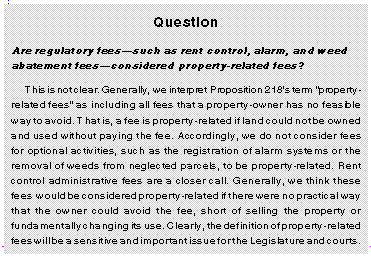
Chapter 4
Raise New Revenues?
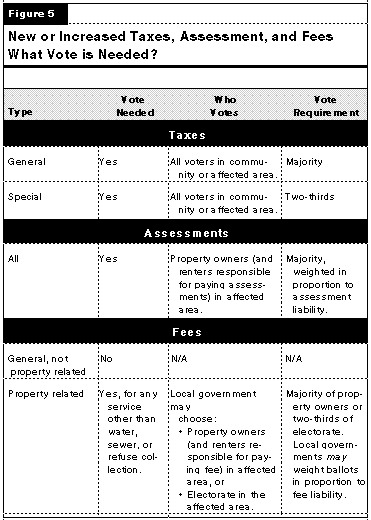
Requirements for New Taxes
In order to impose or increase a tax, local government must
comply with the following provisions:
Requirements for New Assessments
All new or increased assessments must follow the assessment
calculation and election requirements discussed in the previous
chapter. There are no exceptions to this requirement.
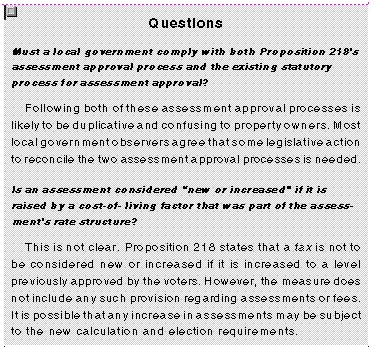
Requirements for New Fees
To impose a new or increased property-related fee, local
government must comply with the fee restriction and fee rate
calculation requirements discussed in the last chapter.
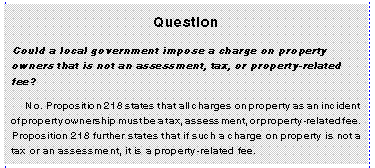
Chapter 5
Assessments, and Fees?
Proposition 218 expands California residents' power to
challenge local revenue raising measures.
Greater Initiative Powers
Prior to Proposition 218, the extent to which local residents
could use an initiative to challenge local government revenue
raising methods was not certain. In a 1995 case, Rossi v. Brown,
the California Supreme Court ruled that people had the power
to use the initiative to repeal a minor tax. There have been no
court rulings, however, addressing the question of whether an
initiative may be used to repeal a more substantial revenue source.
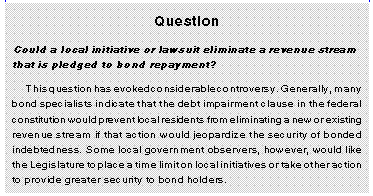
Shift of Burden of Proof
Prior to Proposition 218's passage, the courts allowed local
governments significant flexibility in determining fee and
assessment amounts. A business or resident challenging the
validity of a fee or assessment carried the "burden of proof" to
show the court that the fee or assessment was illegal.
Proposition 218 changed this legal standard by shifting the burden
of proof to local governments. Now local governments must prove
that any disputed fee or assessment charge is legal.
Appendix I:
Clarification May Be Needed
As we discuss throughout this guide, while Proposition 218
is quite detailed in many respects, some important provisions are
not completely clear. This appendix summarizes the major
questions regarding Proposition 218 that must be resolved so
that local governments can begin implementation.
Property-Related Fees
Assessments
Elections
Taxes
Debt
Appendix II:
RIGHT TO VOTE ON TAXES ACT
SECTION 1. TITLE.
This act shall be known and may be cited as the ''Right
to Vote on Taxes Act."SECTION 2. FINDINGS AND DECLARATIONS.
The people of the State
of California hereby find and declare that Proposition 13 was intended to provide
effective tax relief and to require voter approval of tax increases. However, local
governments have subjected taxpayers to excessive tax, assessment, fee and
charge increases that not only frustrate the purposes of voter approval for tax
increases, but also threaten the economic security of all Californians and the
California economy itself. This measure protects taxpayers by limiting the methods
by which local governments exact revenue from taxpayers without their consent. SECTION 3. VOTER APPROVAL FOR LOCAL TAX LEVIES.
Article XIII
C is added to the California Constitution to read:
ARTICLE XIII C
SECTION 4. ASSESSMENT AND PROPERTY RELATED FEE REFORM.
ARTICLE XIII D
SECTION 5. LIBERAL CONSTRUCTION.
The provisions of this act shall
be liberally construed to effectuate its purposes of limiting local government
revenue and enhancing taxpayer consent.
SECTION 6. SEVERABILITY.
If any provision of this act, or part thereof,
is for any reason held to be invalid or unconstitutional, the remaining sections
shall not be affected, but shall remain in full force and effect, and to this end
the provisions of this act are severable.
This report was prepared by Marianne O'Malley
Under the supervision of
Mac Taylor.
To request publications call (916) 445-2375.
This report and others are available on the LAO's World Wide Web site
at http://www.lao.ca.gov.
The Legislative Analyst's Office is located at 925 L Street, Suite 1000,
Sacramento, CA 95814.